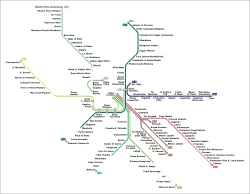| Roma Termini–Cassino | |||
|---|---|---|---|
| | |||
 | |||
| Overview | |||
| Status | Operational | ||
| Line number | FL6 | ||
| Locale | Rome, Italy | ||
| Termini | |||
| Stations | 22 | ||
| Website | trenitalia.com | ||
| Service | |||
| Type | Regional rail | ||
| System | Lazio regional railways | ||
| Operator(s) | Trenitalia | ||
| Daily ridership | 50,000 | ||
| History | |||
| Opened | 1994 | ||
| Technical | |||
| Line length | 137 km (85 mi) | ||
| Number of tracks | 2 | ||
| Track gauge | 1,435 mm (4 ft 8+1⁄2 in) | ||
| Electrification | 3,000 V DC | ||
| Operating speed | 60 km/h (37 mph) (ave) | ||
| |||
The FL6 (until 2012 FR6) is a regional rail route. It forms part of the network of the Lazio regional railways (Italian : ferrovie regionali del Lazio), which is operated by Trenitalia, and converges on the city of Rome, Italy. [1]
Contents
The route operates over the infrastructure of the Rome–Cassino–Naples railway. Within the territory of the comune of Rome, it plays the role of a commuter railway. [2] It is estimated that on average about 50,000 passengers travel on an FL6 train each day.
The designation FL6 appears only in publicity material (e.g. public transport maps), in the official timetables, and on signs at some stations. The electronic destination boards at stations on the FL6 route show only the designation "R" and the relevant train number. [2]

